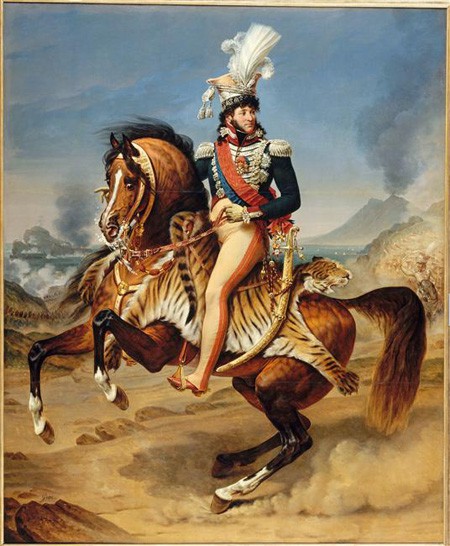Presented at the 1812 Salon, this portrait by Antoine-Jean Gros of Joachim Murat, King of Naples, on horseback in 1806 echoes another work that Murat had commissioned: The Battle of Aboukir, July 25, 1799, a monumental painting (5.78 m 9 68 m Palace of Versailles), which remains one of the greatest Orientalist masterpieces of the Empire.
The scene of the battle of Aboukir celebrates a glorious moment in Murat’s military past in which when he launched his charge against the Ottoman cavalry as it was protecting the fort of Isthmus in the bay of Aboukir. Gros himself described the scene as a life-saving operation, in his presentation of the painting for the 1806 Salon: Murat soars against the Ottomans who had come “to cut off the heads of the French soldiers left dead or wounded on the battlefield.” The painting was not received well by the press but Murat must have liked it as indeed, five years later, when he commissioned from Gros an official portrait of himself as King of Naples, he asked him to make a reference to that brilliant episode in his career as a general twelve years earlier. Orientalising details such as the tiger skin (adorned with ruby eyes, according to the statements of a Saxon in 1813) on which he rides in the fashion of a “Mameluke” and the Turkish sabre that he carries both evoke the earlier painting. And even the posture of his horse as if ready to pounce into a cavalcade, the dust flying up beneath his feet, is itself both literally and symbolically reminiscent of Aboukir where indeed such an act had made his reputation.
Murat’s career had made amazing progress since that battle: having become Napoleon’s brother-in-law through his marriage to Caroline Bonaparte a few months after Aboukir (18 January 1800), the innkeeper’s son had made his way up the Imperial hierarchy, thanks to his bravery on the battlefield. Gros illustrates this quality several times in such imposing compositions as “The Battle of the Pyramids” or “Napoleon on the battlefield of Eylau” during which Murat had made a famous charge, despite being almost knocked out by fever at that moment (both these paintings are now in the Louvre). The purpose of these commissions – the first of which was commissioned by Bonaparte, the second when he was Emperor – was to celebrate the achievements of the French Empire: Gros did not miss the chance to immortalise the military achievements of another of his greatest patrons in these two history paintings.
When Murat commissioned this portrait from Gros in 1811, he was at the summit of his fame. His progress went beyond military hierarchy; he was already Grand Duke of Cleves and Berg; and in August 1808 he became king of Naples. Therefore the artist chose to represent him supervising military manoeuvres on the outskirts of Naples: the presence of Mount Vesuvius in the background of the scene points to its geographic location, while the difference in uniform between the events of Aboukir and of 1811 confirms the new position of Murat. The relatively sober uniform of Aboukir (Murat had allowed himself a few decorative elements) has given way to a second costume of “colonel des chevau-légers de la Garde impériale”. This time the King of Naples gave himself full permission for exuberance: his fur hat had been customised (it was missing a front visor) and the tight winter pants that he wore are those of an aide-de-camp. An 1808 portrait of the King of Naples commissioned from the Baron Gerard differs significantly from Gros’s portrait of 1811: here his badge of the Legion d’honneur comes before the high plate of the Neapolitan order: the French decoration is in first place, therefore. If the context of this painting is less violent than that of Aboukir, it remains an image of a warrior and the vivid colours of the uniform dynamise the rather traditional pose of the “equestrian king”.
Painter of war, violence and imperial propaganda, Gros was cherished and protected by Murat as indeed by Berthier, the Minister of War from 1799 to 1807 who commissioned from him the decoration of the Château de Grosbois around 1809. In 1812 Gros made another sketch for Murat; it evokes Murat’s role in the capture of Capri against British Forces in 1808 (Fondation Dosne-Thiers, Paris). But events were precipitated with the campaign of France and honourable commissions were no longer a priority. The end of the Empire and the tragic deaths of its two mentors in 1815 – Berthier’s fall from a window and Murat’s execution in Italy – would be a major turning point in Gros’s career.
Marie de Bruchard, September 2015
tr. Rebecca Young


